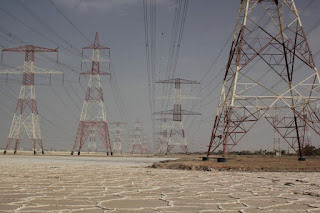Dubai-based
UAE architects make cement out of salt
Dubai-based architect duo is looking to break from
conventional building practices with an alternative cement conceived in the
salt flats of the UAE and made using a problematic waste material.
Wael Al Awar and Kenichi Teramoto, principal architects at
waiwai, enlisted the scientific knowhow of universities in the UAE and Japan to
create a cement made using brine generated by the UAE's desalination plants,
which remove salt from seawater.
They were inspired by the UAE's mineral-rich sabkha -- salt
flats that are part of the country's wetlands. "It a huge area ... that's
often overlooked," Al Awar told CNN.
Sabkha have been used in architecture before: centuries ago, blocks were hewn from salt flats and used to build Siwa, a medieval town in Egypt close to the Libyan border. But rather than mine the delicate sabkha ecosystem, Al Awar and Teramoto turned to waste brine, which contains many of the same minerals.
The freshwater-scarce UAE has one of the largest
desalination operations in the world. It produces roughly one fifth of the
world's brine as a byproduct -- approximately 28 million cubic meters a day,
according to a 2019 UN-backed report. But discharging brine into the sea can
harm marine life. Finding uses for desalination brine has come into national
focus, prompting the launch of a 3.4 million AED ($930,000) "Rethink Brine
Challenge" earlier this year.
Brine contains magnesium minerals. Kemal Celik, an assistant
professor of civil and urban engineering at New York University Abu Dhabi and
part of a team at the university's AMBER Lab, extracted a magnesium compound
from the liquid, and used it to make the cement.
Celik says the cement was cast into blocks, which were then
placed in a carbon dioxide chamber to set -- an innovation which speeds up the
production process. The cement was subjected to testing in the UAE before being
sent to Japan, where blocks went through further strength and rigidity tests.
In addition, an algorithm was developed to calculate how safe the blocks would
be if used in construction, Mika Araki, a structural designer at the University
of Tokyo, told CNN.
Precast blocks could be used to construct a single-story
building "tomorrow," says Al Awar, but he and Teramoto hope to develop
the product further for use in multi-story buildings.
Al Awar claims their magnesium-based cement can
"perform to the equivalent of Portland cement," which uses calcium
carbonate as a raw ingredient and is the most commonly used cement in concrete manufacture.
However, the magnesium cement has its limitations. As a
salt-based product, it is liable to corrode steel reinforcement, he says,
although reinforcement with other materials is possible.
Professor John Provis is deputy head of the Department of
Materials Science and Engineering at the UK's University of Sheffield, and is
unaffiliated with the project. He says the salt-based cement is "a really
good idea," explaining globally only a third of cement is used in
reinforced concrete.
"These brines are a pain to dispose," he adds.
"They're taking a local waste and doing cool things with it. I think it's
a really nice synergy there."
Al Awar says he and Teramoto are motivated by a desire to
construct more sustainable and ecologically friendly architecture. "Given
CO2 emissions in the world and global warming, and all these alarms that have
been ringing for many years, it's our duty -- it's our responsibility -- to
take action," he says.
Cement production is often energy-intensive and has a large
carbon footprint. According to the International Energy Agency, the cement
sector is the third-largest industrial energy consumer in the world and
responsible for 7% of global carbon dioxide emissions. Celik says establishing
their magnesium cement's carbon footprint is part of an ongoing lifecycle
study, which will compare it to ordinary Portland cement and other materials.
In May 2021, Al Awar and Teramoto will curate the UAE
National Pavilion at the Venice Biennale of Architecture, where the alternative
cement will go on display in their "Wetland" exhibition. The pavilion
will be made from magnesium-based cement, although Celik says the cement will
not be brine-based because they are not yet ready to scale-up production.
"The research is still early," says Al Awar.
"It should go through the natural process of experiments and trial and
error to get somewhere. But we are very optimistic." เว็บพนันออนไลน์



ความคิดเห็น
แสดงความคิดเห็น